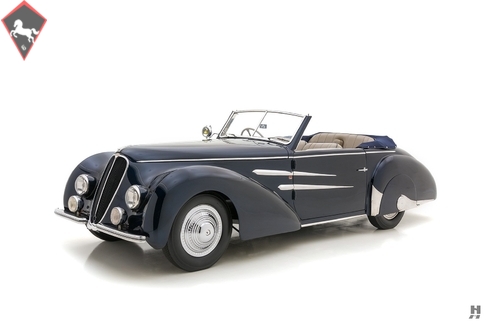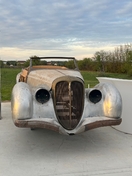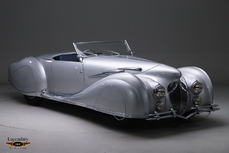Delahaye 135 1946
General description :
From its foundation in 1894, Delahaye quickly rose to prominence in the French motor industry. Their reputation for quality and performance resulted from their exploits at Le Mans and elsewhere across Europe in the highly competitive world of Grand Prix racing. In 1935, Delahaye unveiled a new car that became one of the most successful models in its history – the Type 135. Aside from being a natural-born competitor, the Type 135 chassis was also a darling of the prestigious French coachbuilding industry, proving to be the canvas of choice for many a masterpiece of French design from highly prestigious firms including Chapron, Franay, and Figoni et Falaschi.
As the dust of war settled, the citizens and industry of France emerged from the rubble battered but far from broken. Delahaye reopened its factory, initially just for 3 ½ -ton truck production, which paid the bills thanks to the high demands of Reconstruction. In 1946, the Type 135M resumed production, and Delahaye was finally back in the business of building France’s premier sportscars. Engineers revised the 135 with a widened track for better handling and improved the overhead valve six-cylinder engine, offering up to 130 horsepower for the “MS” and considerably more for racing. The emerging postwar aesthetic proved a fine match for the superb chassis, and bodies varied as widely as owners’ personalities. Ultimately, Delahaye built 1,155 post-war Type 135s through 1952, but sadly, it was all over in 1954 following a merger with Hotchkiss.
The Delahaye offered here is one of a scant few Type 135s with coachwork by Worblaufen of Berne, Switzerland. Carrosserie Worblaufen may be a lesser-known coachbuilding firm, yet they enjoyed a quiet reputation for superb quality craftsmanship and tasteful, understated design. Fritz Ramseier founded the firm in 1929 in his home village of Worblaufen and was joined by his brothers Earnst and Hans, who assisted with sales and running the workshop, respectively. Their early work consisted mainly of drophead versions of humble Opels, Renaults, and Peugeots, but soon, a more sophisticated clientele came calling. Before long, chassis from Mercedes-Benz, Alfa Romeo, Lancia, and Isotta-Fraschini were dotted throughout the workshop. Delahaye was an ideal fit for Worblaufen’s style and quality, and the firm bodied about a dozen chassis in-period, of which just four or five survive.
According to Club Delahaye historians, chassis number 800319 is one of nine Worblaufen-bodied Delahayes known to survive. While the earliest history it not known, it was likely sold to a Swiss owner considering the choice of coachwork. In the early 1990s, it was owned by known marque enthusiast James Brandy of Oakdale, Pennsylvania. He placed an advert in a French newspaper listing the car for sale, with photos showing it in unrestored but complete condition. It was subsequently restored in an American restoration shop for a Mr. John McDonald, who traded it to the most recent owner in the late 1990s.
As offered, it is in lovely condition with a well preserved restoration. Some subtle alterations were made to the design during its restoration, with notable elements including low-mounted Marchal headlamps, rear wheel spats, and polished body side trim. These touches were inspired by similar Worblaufen designs used on Alfa Romeo chassis and highlight its graceful, curvaceous lines. Gorgeous ventilated wheel covers and black wall tires provide the perfect finishing touch to this sporting grande routière. The restoration has matured gracefully, displaying excellent, consistent finishing of the dark metallic blue paint and brightwork. Worblaufen coachwork is highly regarded for its impressive quality, which is apparent throughout this marvelous automobile.
The lovely interior offers plenty of room for four passengers. Like the exterior, the soft trim is well preserved since its restoration and presents in excellent condition with attractive taupe-colored leather piped in blue, matching light tan carpets, and a woodgrain-effect instrument panel. Switches and controls are in good order, including the correct O.S. dials and three-spoke banjo steering wheel. Understated yet luxurious, the cabin is undoubtedly a marvelous place to spend the day motoring along your favorite roads.
The side-hinged bonnet opens to reveal the period-correct OHV inline-six equipped with triple carburetors and backed by a four-speed Cotal pre-select gearbox. Club experts believe this car originally had the preferred three-carburetor “MS” engine, making the current unit true to original specs. The engine bay is well detailed, tidy, and honestly presented, with authentic ancillaries and paint finishes. It runs well and is ideally suited for further preparation for touring and road events.
Of the approximately 45 known examples of Worblaufen coachwork extant, this marvelous Delahaye is certainly one of the standouts. It is a beautiful machine that combines the best restrained Swiss aesthetics and sporty French underpinnings in a beautifully crafted package.
Offers welcome and trades considered
1946 Delahaye 135 is listed for sale on ClassicDigest in St. Louis by Hyman Ltd. for $389500.
Car Facts
Car type : Car Make : Delahaye Model : 135 Engine size : 0.0 Model Year : 1946 Sub type : Convertible Location : Missouri Vehicle Registration : Undefined
389500 $
People who viewed this Delahaye 135 also viewed similar Delahaye listed at ClassicDigest
Other cars listed for sale by this dealer
About Delahaye
Once upon a time, in a land known for its wine, cheese, and snobbish waiters, the French decided to build cars. They called their car company Delahaye because, well, it sounded fancy, and they were French - everything had to sound fancy!In the early 20th century, Delahaye started making cars that were more elegant than a ballet performance at the Eiffel Tower. Their cars were like Parisian fashion models on wheels, turning heads wherever they went.
But the French, being the French, decided to make things a bit confusing. They named their cars with a bunch of numbers like 135 and 165. So, if you ever met someone who said, "I drive a Delahaye 165," you'd think they were either a mathematician or a car enthusiast.
Now, let's talk about Delahaye's American adventure. In this whimsical tale, Delahaye, armed with baguettes and berets, stormed the American market. They didn't actually do this, but let's pretend they did!
Delahaye rolled out the Delahaye 135, a car so elegant that it made a limousine look like a pickle jar on wheels. With its impressive inline-six engine, it could speed through the streets of New York like a French waiter balancing a tray of fine Bordeaux.
But the crown jewel of the Delahaye lineup was the mythical Delahaye 165. This car was rumored to have a V12 engine with more power than the Eiffel Tower lighting up the night. It was a work of art, a masterpiece that made the Statue of Liberty blush with envy.
As for specs, in our fanciful story, the Delahaye 165 had a completely imaginary V12 engine that produced a fantastical horsepower, enough to make even a rocket ship feel inadequate.
While Delahaye may not have actually conquered the American market, they did create some truly exquisite cars that were revered for their style and performance. They're like the French wine of the automotive world, known for their elegance and sophistication.
Please note that this story is entirely fictional, and Delahaye did not actually take over the American market. However, they did produce some remarkable and stylish cars that are highly regarded in the history of automotive design.

























